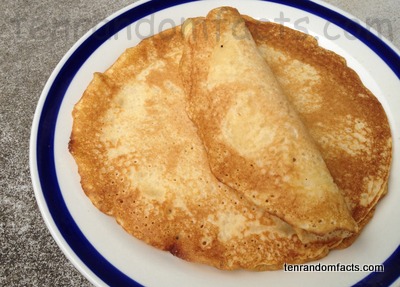These pancakes are hot fresh from the pan.
- Pancakes are a flat food item, typically made by frying a type of batter, though variations can be made with a dough mixture.
- Pancakes typically consist of wheat or other grain, in addition to milk and eggs, sometimes with the addition of sugar, butter, or flavour like vanilla.
- ‘Pancakes’ are also known as ‘flapjacks’, ‘hot cakes’, ‘hoe cakes’ or ‘griddlecakes’, and thin ones are usually known as crêpes, while variations from countries around the world will usually have a different name.
- Pancakes are often eaten in combination with ice-cream, honey, maple syrup, jam, cream, lemon juice and sugar, meat and/or fruit pieces, and sometimes fruit, vegetables or meat can be added to the batter prior to cooking.
- Different cultures have their own forms of pancakes that use various ingredients or methods to make them, though the finished product is typically cream to gold in colour and is roughly circular or oval in shape.
- Shrove Tuesday, or ‘Pancake Day’ as it is sometimes called, is the day before Lent on a religious calendar, particularly in English speaking countries, and the day will often involve the consumption of this popular food.
- In early times, flat grain-based food items, similar to pancakes, were thought to be cooked on hot rocks, while the Ancient Greeks, and the Ancient Romans to an extent, would cook something comparable to our modern style ones, and these were known as ‘tēganitēs’ or ‘alia dulcia’ and often eaten with honey.
- Pancakes are commonly served as a breakfast or brunch dish, though they are sometimes served as a dessert, or they can be part of a main meal, and they can have a savoury or sweet flavour.
- Pancake batter is usually poured or spooned onto, and cooked on, a griddle, frypan, or other flat based cooking surface, and once the batter starts bubbling during the frying process, it is typically flipped over to cook and brown the other side.
- Some people have what is called ‘pancake syndrome’, where flour contaminated with mites will be cooked in the food, notably in tropical and subtropical areas, causing anaphylactic reactions upon consumption, and to avoid this issue, the flour can be stored in the refrigerator.
Bibliography:
Pancake, 2016, Wikipedia, https://en.wikipedia.org/wiki/Pancake
Pancake Syndrome (Oral Mite Anaphylaxis), 2009, US Natural Library of Medicine, http://www.ncbi.nlm.nih.gov/pmc/articles/PMC3651046/
Rupp R, Hot off the Griddle, Here’s the History of Pancakes, 2014, The Plate – National Geographic, http://theplate.nationalgeographic.com/2014/05/21/hot-off-the-griddle-heres-the-history-of-pancakes/







